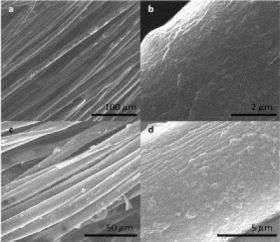Clothing with a brain: 'Smart fabrics' that monitor health

Researchers in United States and China are reporting progress toward a simple, low-cost method to make "smart fabrics," electronic textiles capable of detecting diseases, monitoring heart rates, and other vital signs.
A report on these straight-out-of-science-fiction-fibers, made of carbon nanotubes, is scheduled for the December 10 issue of ACS' Nano Letters.
In the new study, Nicholas A. Kotov, Chuanlai Xu, and colleagues point out that electronic textiles, or E-textiles, already are a reality. However, the current materials are too bulky, rigid, and complex for practical use. Fabric makers need simpler, more flexible materials to make E-fibers practical for future applications, they say.
The scientists describe development of cotton fibers coated with electrolytes and carbon nanotubes (CNT) — thin filaments 1/50,000 the width of a single human hair. The fibers are soft, flexible, and capable of transmitting electricity when woven into fabrics.
In laboratory tests, the researchers showed that the new E-fibers could light up a simple light-emitting diode when connected to a battery. When coated with certain antibodies, the fibers detected the presence of albumin, a key protein in blood — a function that could be used to detect bleeding in wounded soldiers. The fabrics could also help monitor diseases and vital signs, they say.
Article: "Smart Electronic Yarns and Wearable Fabrics for Human Biomonitoring made by Carbon Nanotube Coating with Polyelectrolytes", pubs.acs.org/stoken/presspac/p … ll/10.1021/jf8016095
Provided by American Chemical Society





















